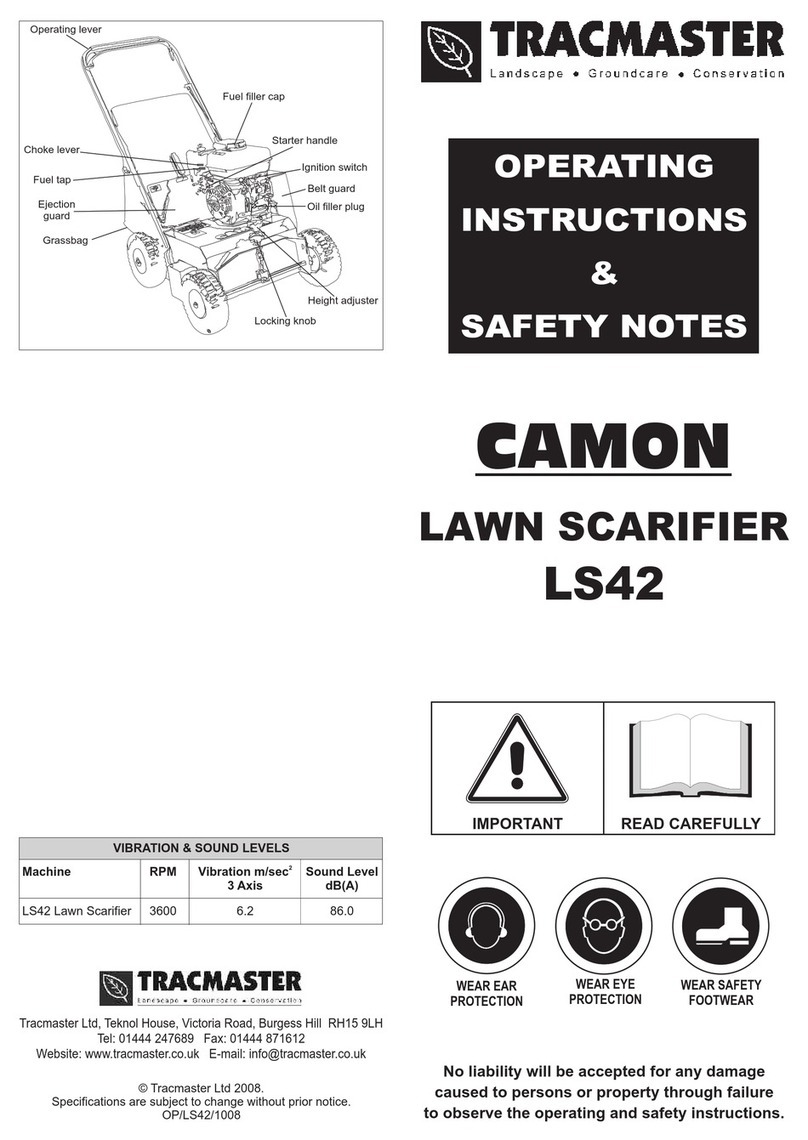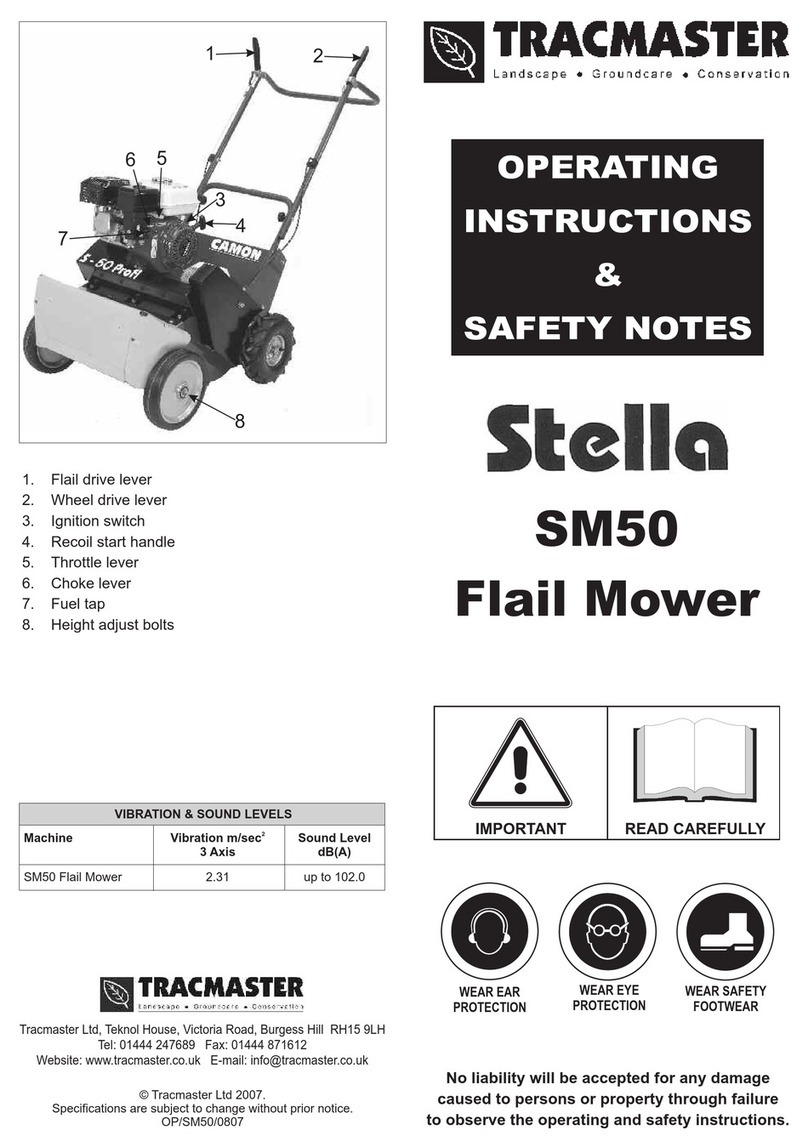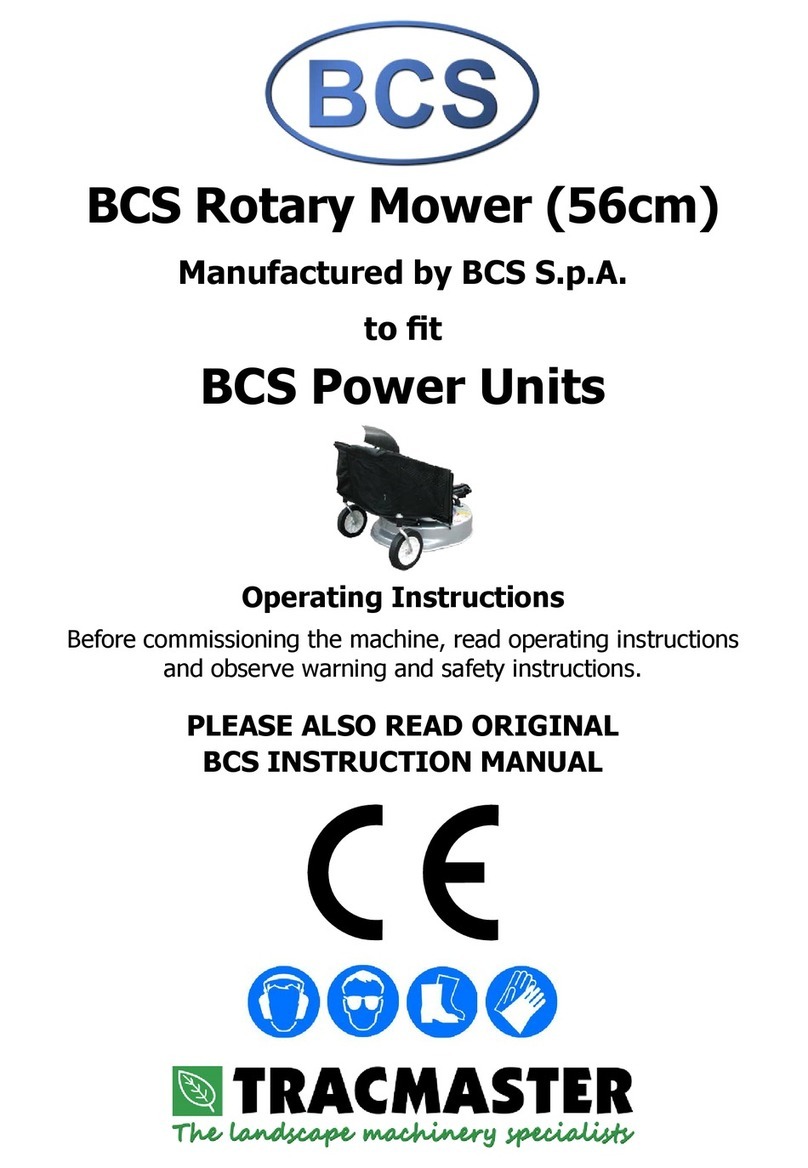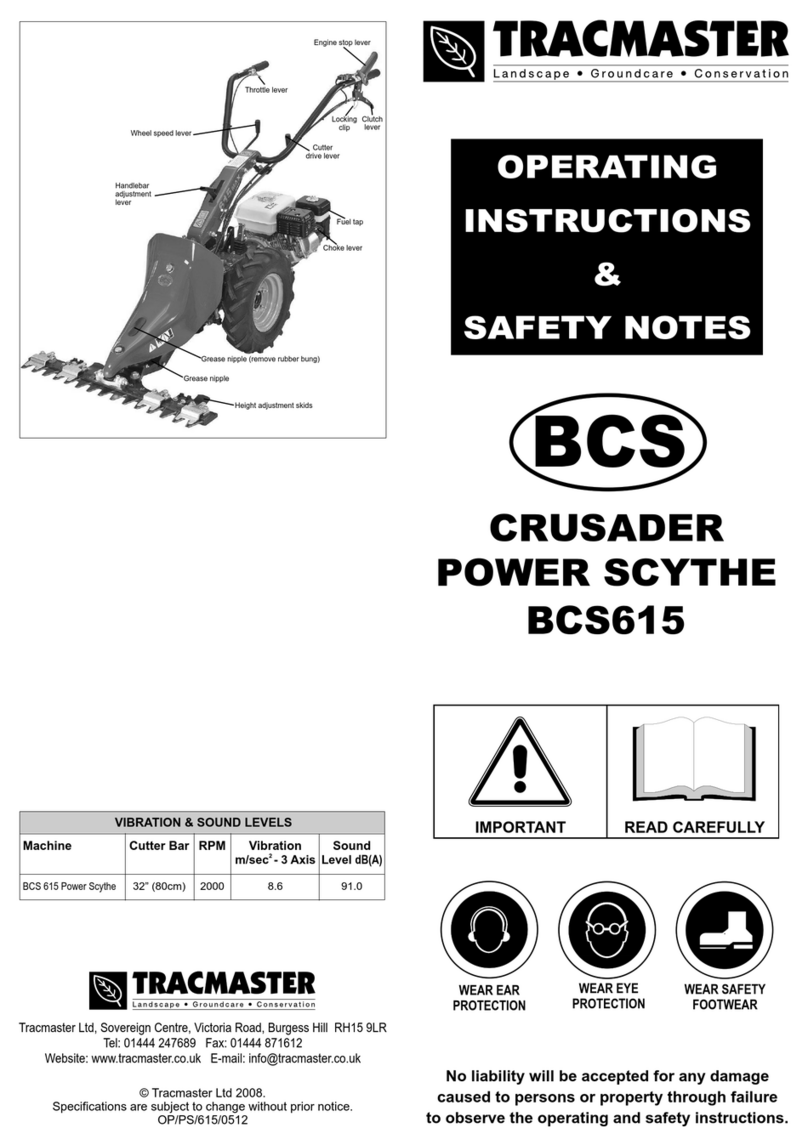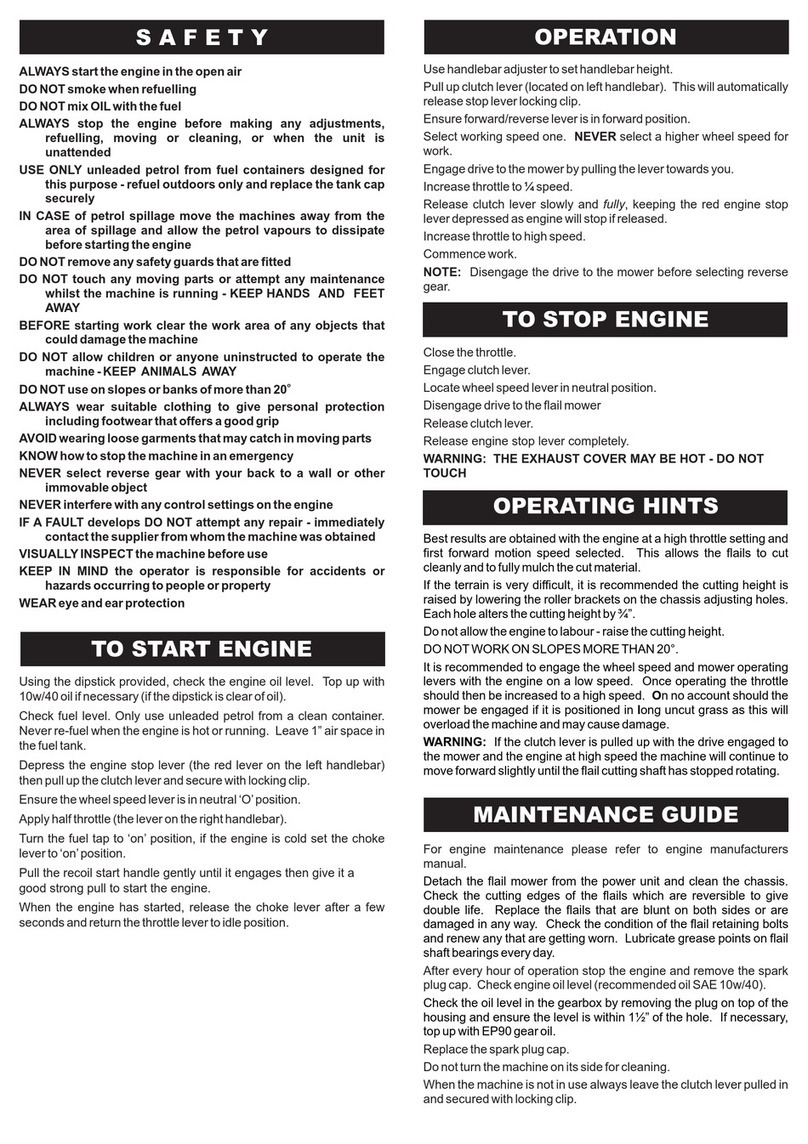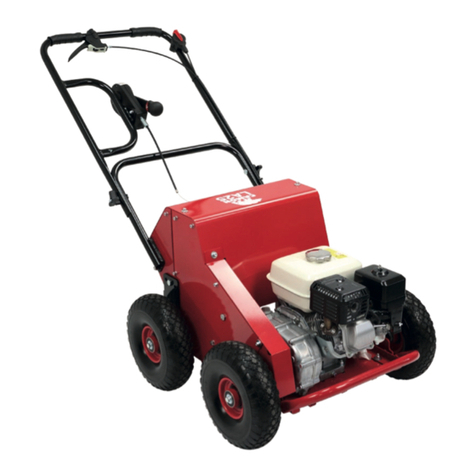S A F E T Y
TO START ENGINE
ALWAYS start the engine in the open air
DO NOT smoke when refuelling
DO NOT mix OIL with the fuel
ALWAYS stop the engine before making any adjustments,
refuelling, moving or cleaning, or when the unit is unattended
USE ONLY unleaded petrol or diesel from fuel containers designed
for this purpose - refuel outdoors only and replace the tank
cap securely
IN CASE of petrol spillage move the machines away from the area
of spillage and allow the petrol vapours to dissipate before
starting the engine
DO NOT remove any safety guards that are fitted
DO NOT touch any moving parts or attempt any maintenance
whilst the machine is running - KEEP HANDS AND FEET
AWAY
BEFORE starting work clear the work area of any objects that
could damage the machine
DO NOT allow children or anyone uninstructed to operate the
machine - KEEP ANIMALS AWAY
o
DO NOT use on slopes or banks of more than 20 - unless you are
using the Kohler engine machine
ALWAYS wear suitable clothing to give personal protection
including footwear that offers a good grip
NEVER put hands or feet under mower decks
AVOID wearing loose garments that may catch in moving parts
KNOW how to stop the machine in an emergency
NEVER select reverse gear with your back to a wall or other
immovable object
NEVER interfere with any control settings on the engine
IF A FAULT develops DO NOT attempt any repair - immediately
contact the supplier from whom the machine was obtained
VISUALLY INSPECT the machine before use - ensure all tines, nuts
and bolts are tight and not worn or damaged and replace tines
if necessary
KEEP IN MIND the operator is responsible for accidents or hazards
occurring to people or property
WEAR eye and ear protection and protective footwear
Check the fuel level - use either unleaded petrol or diesel, depending on
your engine type.
Always remove the fuel cap slowly to release tank pressure and keep
your face and eyes away from the tank.
Check the engine oil level.
Ensure the butterfly is in the central position (L).
Pull in the clutch lever and secure with locking clip (B & F).
Ensure PTO lever is disengaged (E).
Turn the fuel tap to ‘ON’ position - if the engine is cold turn on the choke -
petrol engine only.
Apply half throttle.
Gently pull the recoil starter handle until resistance is felt and then give a
good strong pull to start the engine.
Push the choke back in and return the throttle to idle speed (petrol
engine only) and allow the engine to idle for 2-3 minutes. This will allow
the oil to warm up to ensure correct operation.
Pull in the clutch lever (B).
Close the throttle (C).
Ensure the butterfly is in the central position (L).
Disengage the PTO drive to the implement (E).
Release the clutch lever slowly (B).
Release the red stop levers (A).
WARNING: If any abnormal vibrations or sounds occur, STOP the
engine and check the machine and the implement.
WARNING: THE EXHAUST COVER MAY BE HOT - DO NOT TOUCH
TO STOP ENGINE
OPERATION
MAINTENANCE GUIDE
Pull the clutch lever up to the handlebar to release the locking clip (B & F).
Select the working speed required for mowing, sweeping, or snow
clearing by using the right-hand gear lever (D).
Engage drive to the implement by using the PTO left-hand gear lever (E).
Increase engine speed (not if the scythe cutter bar attachment is in use)
and release the clutch lever slowly and fully (C & B).
Keep at least one red engine stop lever depressed as the engine will
stop if both are released (petrol engines).
Push the butterfly clockwise to move the machine forwards. When fully
depressed clockwise, the butterfly will lock in place. To release simply
push anti-clockwise (L).
Steer the machine by pulling in the steering clutch levers fully and
releasing the lever fully as required (H & I).
NOTES: PTO lever (E) must only be operated with the clutch lever (B)
pulled up and the engine on tick over.
Never change wheel speed when driving the machine. It must be
stopped first.
Do not operate both steering levers together to stop the machine.
NOTE: With the engine running and the butterfly (L) in the central
position if the clutch lever (B) is released the machine will not move but it
st nd rd
is possible to select 1 , 2 , or 3 gear (D).
Push the butterfly anti-clockwise to reverse the machine. When fully
depressed anti-clockwise the butterfly will lock in place, to release
simply push clockwise (L).
WARNING: Never engage reverse gear with your back to a wall, fence
or other immovable object.
ENGINE - See separate engine manufacturer’s manual.
GEARBOX - Check oil level using the oil plug (A) ensuring level is
between (B) and (C). If necessary top up with AGIP Rotra JD/F 80W or
Shell Donax TD or equivalent.
CLUTCH - Check there is
sufficient free play in the cable.
As the clutch wears, the cable will
tighten up. Release the adjuster
on the clutch lever and screw in to
increase the free play. On no
account must the cable be tight.
The cable end float should be
approximately 3mm.
S T E E R I N G C L U T C H E S -
Steering clutch cables act on the
long black levers on the side of
the wheel hubs. Ensure the end float of these cables is 2-3mm. If
necessary screw in the adjuster on the steering lever to increase free
play.
GENERAL - Keep all cables lubricated and grease the detent ball on
the wheel speed selector gate. Check the tightness of all nuts and bolts
at regular intervals.
Always store the machine with the clutch lever pulled in and secured
with the locking clip.
This machine is fitted with an automatic parking brake which is engaged
when the engine is off and when the engine is running with the butterfly
in the central position.
On the gearbox cover there is a red lever which if turned clockwise
disengages the parking brake to allow the machine to be pushed.
To re-engage mechanical traction to the wheels turn the red lever anti-
clockwise to its original position.
(A)
To stop the machine release the butterfly and allow it to return to the
central position (L).
To stop the machine release the butterfly and allow it to return to the
central position (L).
REVERSING
The gearbox oil must be changed every 50 hours to ensure
correct operation of the machine.

